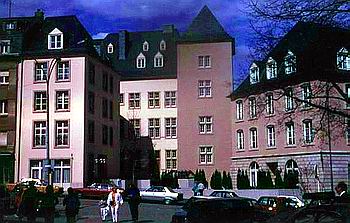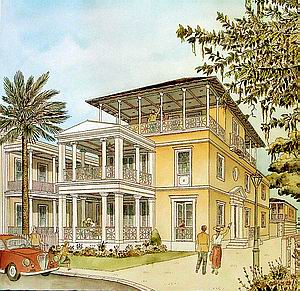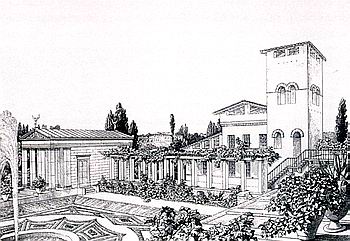|
"......the prevalent consideration of
the classical tradition revolves around the theory of decorum. Decorum refers to that which is 'fitting'. In its Latin use
decorum had the same sense of the proper, suitable, or seemly which it still carries in English.
In architecture, decorum came to mean the appropriateness of form to the program and to the physical
or social context and ciecumstances. Hence the beauty arising from fitness. In this context, the romantic conception of style
is of little use and, instead, we must turn to the classical concept of character."
Demetri Porphyrios
"Classical Architecture"

Reconstruction of Ilot Clairfontaine, Luxembourg
by Herr & Huyberechts, Luxembourg
(Photo by Lucien Steil)
"The idea of character as a theoretical
concept originally derives from Aristotle's theory of human nature. In his 'Poetics', Aristotle pointed out that all people
are marked by specific physical and behavioural attributes. More importantly for Aristotle, character was an expression of
moral purpose. It was only later, when Greco-Roman rhetoricians gave different literary treatment to their subjects in oratory,
that character came to mean style, in the sense of personal expression. The classical idea of character, however, never stressed
individual but always typical traits."
Demetri Porphyrios
"Classical Architecture"

Tasis, American School in Lugano, Switzerland
Art Studios Building
by David Mayernik
"For the classical mind, everything in
the world has a character of its own in the sense that it bears distinctive features by which we can recognise it. In a manner
similar to nature, therefore, those artefacts made by the craftsman and artist must also be given their own distinctive character.
Character here is not meant to facilitate the recognition of the artist's hand; it is rather an attribute
that assigns proper and typical features to artefacts, so they may speak of their purpose, rank, and immediate context or
distant ancestors."
Demetri Porphyrios
"Classical Architecture"
(Andreas Papadakis Publisher,
1998)

New House in I'On, Pount Pleasant, South Carolina
by Deupi & Ekonomakis Partnership
Style and Character

Gärtnerhaus, Charlottenhof, Potsdam
by Karl Friedrich Schinkel
Style in terms of language is the highest
achievable perfection and consistence of form, vocabulary, composition, elegance of phrasing and of expression, correctness
of orthography, relationship of form and content, constructional logics and tectonic poetry.
Wether it is a national, regional or local language or dialect does not really matter so much, though we
might acknowledge 'high styles' nd 'vernacular idioms'.
Style in terms of language means communicating ideas and ideals in the most beautiful and cultivated form...,
and this can address the universal or the particular, the local or the national, the collective or the personal,
the public or the domestic, the classical or the vernacular.
Character is not a substitute for style. It is not particularly linked to the regional or vernacular
and should not be taken as a subordinate theory of art psychological nature or of purely
allegorical substance or of some purely local signature!
Character articulates the nature of a building, building ensemble or urban structure and it specifies their
role and category, the relative importance and the essence of their purposes, their hierarchy, their functions, their
class, their inhabitants, their location (in the city and countryside within a specific culture, geography, climate,
history, etc.), their symbolic program and role, etc.
Style supports the articulation of character and vice-versa, but there is not a necessary direct causality
between character and a particular historical style.
It is only by integrating style, character and type that it will be possible to define and evaluate an
architectural or urbanistic creation. Architectural treatises have generally offered and discussed a wide range of conceptual
tools to address appropriately architectural and urbanistic practice and there seem not to be any reasons not to refer to
them in a contemporary situation.

New Youth Hostel in Bornstedt, Potsdam
by The Prince of Wales's Urban Design Task Force 1996
(Drawing by Diego Montero)
|
